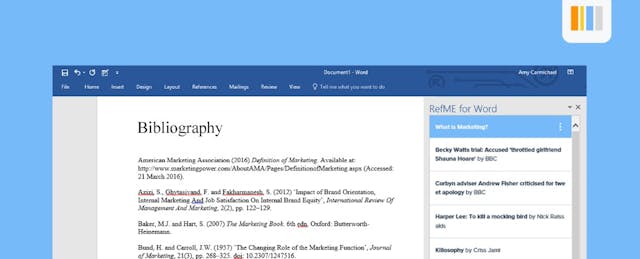Citations are the building blocks of research. Without them, academic work would have no context or connection to previous discoveries. But they’re also the bane of many students’ and academics’ existence. The tedious task of compiling references and bibliographies can quickly offset the joy of finishing a research paper.
ReME, a tool for managing citations in the cloud, today announced a new set of premium features, including Microsoft Word integration and print-to-digital text conversion, to take some of the headache out of referencing sources for students and institutions.
Born in 2014 out of founder Tom Hatton’s frustration with existing referencing software, London-based RefME has quickly grown to more than one million users who use its tools at more than 14,000 institutions. Students use its free web platform and mobile app to automatically generate citations for a wide variety of research materials, such as websites and YouTube videos. They can save sources to the cloud from their browser or scan the barcode of a physical book or journal they’re reading. The app automatically creates a reference in one of more than 7,500 citation styles including Harvard, MLA and APA.
Some academics argue that automatic citation belittles the research process, but RefME claims its tool lets students spend more time thinking about the content of their work rather than worrying about formatting.
The company maintains that its citation features will remain free. “RefME's goal has always to keep the core utility free to help create a level playing field within education,” Hatton tells EdSurge. “The main focus on RefME Plus and RefME Institute is to offer additional functionality outside of the ability to create a citation. "RefME Plus is the new premium offering for individuals. A $32.99 yearly subscription comes with a plugin for Microsoft Word 2016 for Windows and Mac and Word for iPad that connects references to writing. Researchers can add in-text citations and keep bibliographies updated within the document as they write.
The Plus tool includes a feature that uses optical character recognition (OCR) to let users take photos of printed text using their smartphone camera and then turn the words into digital text, making it easier to quote. Soon Plus users will also be able to organize their citations by dragging and dropping them in folders.
RefME is also growing its relationships with colleges and universities. It has already partnered with 15 institutions in the U.S. and the UK, including Oklahoma State and Southampton University, that use its core citation features. They paid a setup fee to get single-sign-on authentication, teaching materials and product support. Now they’ll have the option to purchase access to the Plus features with a new product called RefME Institute.
Institutions can access data on how their students are using RefME, and the company says that within a year it plans to provide libraries with analytics that will inform their cataloguing and purchasing decisions.
RefME raised $5 million in a seed round from GEMS Education in 2015 and says that it will soon announce additional funding. The company also says it’s developing integrations with other word processing tools, such as Google Documents.
Hatton has his eyes on global expansion. "We are already making strides towards having a healthy ownership of the UK and U.S. market, and I foresee us expanding into more territories, supporting more languages and continuing to help students all around the world."


